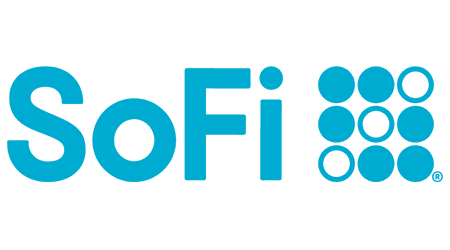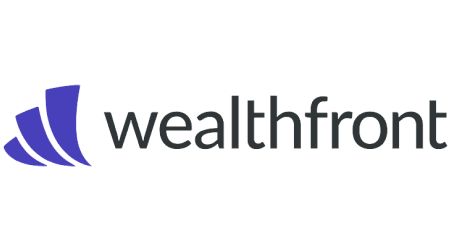Wealthfront is a fintech that mostly focuses on investment services. It has an all-in-one cash account with a very high APY, an optional debit card and extremely high FDIC insurance. SoFi is an online bank, also offering high APYs, high FDIC insurance and an all-in-one account with checking and savings.
If you’re looking for a full bank to handle most-things money, SoFi is probably the better option. But if you want to grow your savings, Wealthfront might be the way to go.
SoFi vs. Wealthfront: A quick comparison
 Sofi |  Wealthfront | |
| Bonus |
|
|
| Checking and savings |
|
|
| ATMs |
|
|
| Branches | Online only | Online only |
Wealthfront vs. SoFi: Account options
SoFi and Wealthfront both offer a hybrid account of sorts, and both are online banking options. SoFi is a fully online bank, and Wealthfront is a fintech with banking partners.
Wealthfront and SoFi feature extremely high FDIC insurance. Wealthfront offers an astronomical $8 million in FDIC coverage with its Cash Account, while SoFi offers up to $3 million on its hybrid Checking and Savings account. For some context, the typical FDIC insurance coverage is just $250,000 per depositor. SoFi and Wealthfront are able to offer higher coverage because they use a network of banks to add that additional coverage.
Banking
Wealthfront and SoFi both offer one account option. SoFi’s is a hybrid checking and savings account, and Wealthfront’s Cash Account is a cash management account.
SoFi’s Checking and Savings account is no stranger to Finder’s list of the best checking accounts. The hybrid account has no monthly fees, and you’ll have two accounts in one.
- The SoFi checking balance earns up to 0.50% APY, and you’ll get great perks like early direct deposit, no overdraft fees, foreign transaction fees or ATM cash withdrawal fees. Also get fee-free access to over 55,000 Allpoint ATMs. And if you opt into savings round-ups, each debit card purchase rounds up to the nearest dollar and deposits the rounded-up amount into your savings.
- The SoFi savings balance can earn either 1.00% or up to 3.80% APY. To earn the higher APY, there are three options: 1) Set up direct deposit to become a Plus member, 2) deposit $5,000 per month, or 3) pay a $10 monthly subscription fee to become a Plus member. You can create up to 20 Money Vaults, which function like subaccounts of your savings, to separate your savings goals.
The Wealthfront Cash Account is somewhat similar to SoFi’s hybrid account, but not quite. Just like SoFi, there are no monthly fees, and it’s an all-in-one digital account. However, there isn’t a separation between your checking and savings balances — it’s basically a checking account with a savings APY, very similar to a money market account, or a cash management account.
- The Wealthfront Cash Account only requires $1 to open and has no requirements to earn the very high 4% APY. You can get free same-day transfers if you do it before 9 p.m. (including weekends and holidays), send checks, pay bills, send wires for free and transfer funds to your investment account. You can also request an optional debit card to spend your cash. Like SoFi, Wealthfront also uses the Allpoint ATM network, but only 19,000 of them give you fee-free access, which is low compared to SoFi’s large 55,000 ATM network.
Borrowing
SoFi has significantly more borrowing options than Wealthfront.
SoFi offers:
- Personal loans. SoFi’s personal loans have no prepayment penalties or origination fees and loan amounts up to $100,000 for various purposes, like debt consolidation, home improvement or vacations.
- Business loans. SoFi offers small business loans with a max amount of $2 million and APRs as low as 3%.
- Mortgages. SoFi’s mortgage services are vast: typical mortgages, cash-out refinance, HELOC, jumbo loans, VA loans and even FHA loans.
- Auto loans. SoFi offers new and used car loans, as well as refinancing.
- Student loans. Private student loans with fixed or variable interest rates.
- Cashback credit card. The SoFi credit card offers 2% to 3% cashback rewards and no annual fee.
Wealthfront offers a line of credit, but it’s only for Automated Investing customers:
- Portfolio Line of Credit. Wealthfront lets you borrow up to 30% of your portfolio with a line of credit. It’s available to taxable Automated Investing clients, and there’s no credit check. A major perk is that there is no set repayment schedule — Wealthfront states you can pay it back “whenever.” Set your own schedule with recurring payments and enjoy no early prepayment penalties or minimum payment requirements.
Investing
Investing is where Wealthfront shines, but SoFi has investing services as well.
- Wealthfront investing. Choose between an individual investing account, joint investment account, IRA or 529 savings plan. Get started with $1 to start investing in more than 1,500 stocks, exchange-traded funds (ETFs) and more, and pay a competitive 0.25% annual management fee. Wealthfront also offers an Automated Investing Account, but that requires a $500 minimum deposit.
- SoFi Invest. Heavily designed for beginners, the SoFi Invest account lets you invest in stocks, options, ETFs, mutual funds and some alternative assets like commodities, private credit and real estate.
Neither SoFi nor Wealthfront have certificates of deposit (CDs), but Wealthfront does offer bonds.
- Wealthfront bonds. Wealthfront offers an Automated Bond Ladder, which is a ladder of US Treasuries. Treasuries are exempt from state and local income taxes, and similar to CDs, the rates with the Automated Bond Ladder are fixed for a set period of six months to six years.
Apps, features and more
If you’re more set on getting a fully online bank with all the bells and whistles, SoFi is a strong contender. SoFi’s app is full of account management controls and features. For example, you can manage the Money Vault subaccounts to set up automatic transfers, set up savings round-ups and manage your balances.
You can also manage investments with SoFi Invest, apply for loans, locate ATMs, perform mobile check deposits and so on. And a major plus with a completely online bank: SoFi offers 24/7 customer support over the phone.
Wealthfront also has a mobile app with stellar ratings. Manage your Cash Account and investments, make mobile check deposits, locate ATMs and set up transfers or initiate transfers to other accounts. But unlike SoFi, you can’t create savings subaccounts, and there aren’t extra perks like savings round-ups or budgeting tools.
How SoFi and Wealthfront’s fees compare
SoFi and Wealthfront both have digital accounts with no monthly fees. Wealthfront just requires $1 to get started with its Cash Account, whereas SoFi has no opening deposit requirements at all.
SoFi doesn’t charge an out-of-network ATM fee. Wealthfront charges $2.50 for out-of-network cash withdrawals and only has 19,000 fee-free Allpoint ATMs compared to SoFi’s 55,000.
However, SoFi has some deposit requirements to earn the 3.80% APY on savings balances. Wealthfront doesn’t have any direct deposit or minimum balance requirements to earn the high 4% APY on the Cash Account balance.
What customers say about SoFi and Wealthfront
SoFi gets pretty decent customer feedback. It has an A+ rating with the Better Business Bureau (BBB), a fantastic 4.6-star rating on Trustpilot and mostly positive feedback on Reddit.
Customers are happy with SoFi’s loans, account, customer service and easy-to-use mobile app. Many of SoFi’s reviews are in direct reference to its personal loans, which are popular for having no origination fees and a seamless application process.
Wealthfront is mostly known as a robo-investing option. It holds a dismal F rating with the BBB and a 3.4-star rating on Trustpilot. But compared to SoFi, Wealthfront has thousands fewer customer reviews and ratings.
On Reddit, most customers say they just use the Cash Account as a savings account thanks to its very high APY but like the option to get a debit card if they want to. Other customers also talk about the very high FDIC insurance, saying they’ve had no issues with the account, and many Redditors share referral codes to earn an APY bonus.
Final verdict: SoFi is better
A tough call, but SoFi comes out on top if you’re looking for a more traditional bank. SoFi has checking and savings, tons of lending options, a larger ATM network than Wealthfront, a cashback credit card, investing services and a souped-up mobile app. While SoFi’s savings APY is slightly lower than Wealthfront’s, Wealthfront simply has fewer features and services than SoFi.
If you want to grow your savings, go with Wealthfront. Its 4% APY on the Cash Account has no balance or deposit requirements, and you can get a debit card if you want. It also has unlimited transactions because it’s a cash account, whereas most savings accounts with APYs that high have transaction limits, often up to six withdrawals per month.
SoFi at a glance
SoFi is the better option if you want somewhere to handle all your basic banking needs.
- No monthly fees
- Interest-bearing checking
- Various loan types
- Large ATM network
- SoFi Invest
- No CDs or bonds
- No physical branches
- Deposit requirements or monthly fee to earn best savings APY
Wealthfront at a glance
Wealthfront is the clear answer for growing your savings, but as a fintech that mostly focuses on investing, it lacks some typical banking products.
- High 4% APY with no requirements
- No monthly fees
- Investing and bonds
- Optional debit card
- Portfolio Line of Credit
- Smaller ATM network than SoFi
- Fewer loan options than SoFi
Alternatives to SoFi and Wealthfront
SoFi and Wealthfront are both digital banking options, but they’re not your only options. If you’d rather have physical branch locations or just a different bank altogether, check out these alternatives:
- Chase. The biggest bank in the US, Chase offers multiple personal and business banking options. It also has a very large branch network for in-person customer support.
- PNC Bank. Another brick-and-mortar bank, PNC Bank offers multiple banking products, lending services and has a large branch network. It also has all-in-one checking accounts called Virtual Wallets, similar to SoFi’s hybrid account.
- Other investing options. Wealthfront and SoFi both have investing services, but if you want more options, compare investing accounts and see how-tos with our investment guide.
See how even more bank accounts stack up:
Ask a question
More guides on Finder
-
Zelle Transfer Limits by Bank
Zelle transfer limits vary by bank. Some of the banks with the highest Zelle limits include Capital One, SoFi, Chase, PNC and Wells Fargo.
-
Zelle Drops Standalone App: Now What?
Zelle users can no longer use its standalone app to send or receive money.
-
Does Capital One Have Zelle?
Capital One does work with Zelle and has one of the highest Zelle transfer limits available. See how to get started here.
-
Does U.S. Bank Have Zelle?
U.S. Bank does integrate with Zelle without needing the discontinued standalone app. Here’s how to use it for personal and business accounts.
-
Ally vs. Capital One: Which Bank Is Better?
Ally and Capital One have similar APYs and no monthly fees, but Ally is online-only and Capital One has some physical locations.
-
Does PNC Have Zelle?
PNC is compatible with Zelle and is easy to integrate. See a step-by-step guide on how to use Zelle with your PNC bank account.
-
SoFi vs. Chime: Which Is Better?
We compare SoFi and Chime side-by-side to help you decide which popular online bank is best for you. See features, pros and cons and more.
-
Citi vs. Chase: Which Bank Is Better?
Chase and Citi are banking giants. Let’s see how they stack up against one another.
-
How to Open a Bank Account Online In 3 Steps
Compare and apply for a bank account with a linked Visa or MasterCard debit card in 10 minutes. Learn what you need to apply and how to get started.
-
How to Close Your Bank Account
Learn how to close a bank account in five simple steps.

